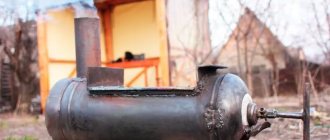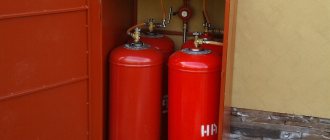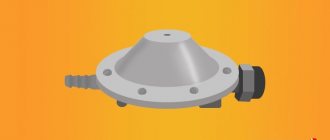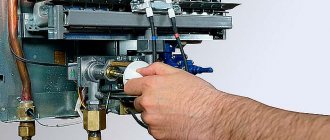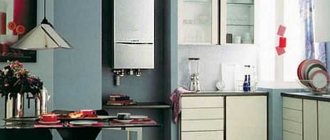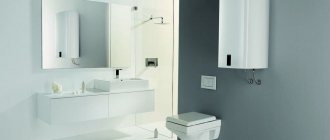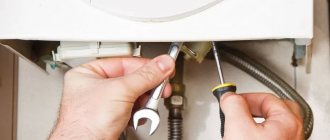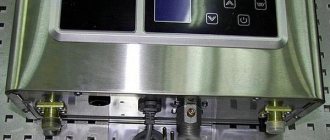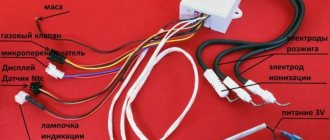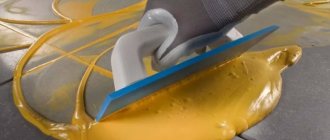Often water heaters are purchased for use at dachas, for work “in the field”. Accordingly, there may be no centralized gas supply in dacha cooperatives and villages. There is a way out - install an electric water heater or choose a gas water heater with the ability to connect to a cylinder. Can a gas water heater run from a gas cylinder? Yes, if the manufacturer has provided such an option. How to connect it and what fuel to use - you will find answers to these questions below.
You can also reconfigure an existing column. To do this, carefully read the instructions in the final part of the article.
How much gas do you need to heat a 100m2 house?
To heat a house of 100 m2, excluding hot water supply, you need to spend 10 kW/h of energy. To obtain 10 kW/h you need 2 liters of liquefied gas, this is the maximum (peak) consumption. In fact, when the boiler enters operating mode, having warmed up the room, fuel consumption becomes an order of magnitude less.
Interesting materials:
Who headed Sberbank? Where to use glass jars? Where can I file a complaint against the bank? Where can I spend Thanks from Sberbank? Where to file a complaint against VTB Bank? Where can I complain about Home Credit Bank? Where to complain about Sberbank insurance? Is it possible to pay for a loan from the Eurasian Bank through Caspian Gold? Is it possible to store Raisins in a glass jar? Can sugar be stored in a glass jar?
Types of fuel for the dispenser
The substances used to heat water are called propane and butane. These are derivatives released during the processing of “black gold” - oil (gasoline, gas). Both pure technical butane and a mixture of butane and propane are used in winter or summer versions.
When compressed, gases turn into a liquid state and occupy less volume. That is why this type of fuel is often called “liquefied”.
When the pressure decreases, the gas turns into a vapor state. Since gas tends to expand at high temperatures, the cylinder is usually filled to 85% of its full volume. If you think that you have not been “refilled” with fuel, this is for your own safety.
Fact! Above the liquid gas there will always be a layer of gas in the vapor state.
Gas cylinder - 100% country option
Often, an instantaneous water heater powered by bottled gas is the only way to heat water for a summer residence. Of course, no one cares about natural heating from the sun, but what to do in winter? The output is a boiler or geyser.
As for an electric water heater, it is not always possible to make a choice in its favor for a simple reason: not all holiday villages have an ideal electrical network that would work without failures and would not irritate with power surges. Those who use electric motors for irrigation, electric saws, air conditioners and other powerful appliances are partly to blame for this. A boiler or an electric instantaneous heater is not always a profitable solution.
Getting a cylinder with a gas mixture is not a problem. Moreover, most domestic manufacturers (and not only) produce gas equipment that operates regardless of what gas is used - regular or liquefied.
Making and installing a chimney with your own hands
The rules for installing outlet channels are the same for speakers of any type and year of manufacture.
Before starting work, it is recommended to consult with specialists. It should be remembered that the connection of the speaker can only be carried out by employees of a certified service.
What materials are best to make it from?
You cannot save money on installing a chimney for a water heater. Firstly, cheap products quickly become unusable. Secondly, they do not differ in the performance required for effective removal of combustion products.
It is advisable to focus on materials that meet the following criteria:
- strength;
- corrosion resistance;
- waterproof;
- fire resistance;
- durability;
- flexibility and elasticity.
Most of all, a double stainless steel pipe with basalt wool insulation meets these requirements.
Drawing and diagrams
Schemes are drawn up on a personal computer or worked out on paper. Preliminary measurements of walls, ceilings and roofs are made.
The drawing is made to scale in order to be able to accurately determine the design’s compliance with SNiP requirements. In addition, according to the scheme, the calculation of the necessary materials for the manufacture of a channel for removing smoke from a water heating column is carried out.
Size calculation
When making calculations, it is necessary to take into account that for water heaters with a vertical pipe it is necessary to provide at least 250 cm of vertical channel.
In addition, the following nuances must be taken into account:
- the diameter of the chimney is not less than the cross-section of the pipe;
- the number of corners is no more than three;
- the total length of horizontal sections is no more than 300 cm;
- a slight slope to the sides of the column is required;
- the permissible slope when walking around building elements is 30 °.
It is not allowed to lead the chimney into a shaft intended for ventilation. This is fraught with an emergency or poisoning of the residents of the house.
Specifics of the technique
Water heating equipment operates using the energy of methane combustion. Performance often depends on the type of device. The devices are divided into 2 types based on their operating principle and design.
Cumulative
In a boiler, water accumulates in a reservoir (tank). Gas burners heat the bottom, creating heat transfer. Air is needed for the normal process. The spent oxygen leaves through a special pipe located inside the container.
Storage devices heat the entire volume of water in the tank to the temperature specified in the settings. If the temperature drops, the equipment is de-energized. The user sets the parameters once, and the equipment independently modulates the flame and controls the flow.
Sectional view of a gas storage device Source progasmarket.ru
Neva-5514
Neva-5514
[gallery2 link=»file» size=»full» ids=»14329,14330,14331"]
| Net power | 28 kW |
| Thermal output | 24 kW |
| Productivity | 13 liters per minute, when heated to +25 C |
| DHW temperature values | From 25 to 65 degrees C |
| Liquid p parameters | 1 mPa |
| Maximum gas pressure | 2.9 mbar |
The model implements more modern principles that make the device more reliable and productive with an efficiency of 87%, so the user rating is a confident 4.
These models of the Neva trademark are characterized by a similar design. The products are made from high-quality materials, such as copper used for the heat exchanger. A 5-stage safety system is provided: when heating up to +90C, in case of failures in resource supply systems, and others. Their differences are only in size and operational parameters. All products can be easily converted to natural gas if a centralized pipeline is connected to your locality. The advantages of Neva geysers for consumers are as follows:
• affordable price for a wide audience of users; • high maintainability, availability of spare parts and their low price; • stable operation in Russian conditions, even with changes in pressure in the water supply; • compact dimensions and pleasant appearance; • the equipment is reliable and characterized by exceptionally quiet operation; • high-quality materials are used in production, which guarantee durability; • wide service network.
The actual resource declared by the manufacturer is 12 years.
Maintenance and cleaning
According to SNiP requirements, exhaust ducts must be inspected and serviced twice a year.
The following points are checked:
- clogging;
- soot thickness;
- integrity of the walls;
- state of traction.
If deviations from the norm are detected, the chimney is partially disassembled, cleaned, repaired or damaged areas are replaced.
What volume of gas cylinder to choose
Based solely on current propane costs, it will be enough to install one 50 liter cylinder. Even with uneconomical consumption of liquefied gas, the fuel should last for 10-15 days. And this is assuming a large family of 4-5 people. The technical data sheet for water heaters states that a 50 liter gas cylinder is enough for 10-12 hours of continuous operation.
Experts recommend connecting a propane dispenser through a ramp. Thus, it is possible to reduce the load when operating a gas water heater from one to several gas cylinders, evenly distributing fuel consumption and preventing freezing of the walls and reducer. Connection via a ramp allows you to install several smaller containers of 25/40 liters each. Or, as an option, use 50 liter cylinders connected in conjunction with each other.
{_downtext}
| Weight and internal volume of gas cylinders | ||||
| Volume (l) | 5 | 12 | 27 | 50 |
| Empty cylinder weight (kg) | 4 | 5,5 | 14,5 | 22,0 |
| Weight of propane cylinder (kg) | 6 | 11 | 25,9 | 43,2 |
| Gas mass (kg) | 2 | 5,5 | 11,4 | 21,2 |
| Cylinder height (mm) | 290 | 500 | 600 | 930 |
| Cylinder diameter (mm) | 200 | 230 | 299 | 299 |
| The volume of gas in the cylinder depending on the capacity | ||||
| Cylinder capacity (l) | 5 | 12 | 27 | 50 |
| Gas capacity (m³) | 0,95 | 2,59 | 5,38 | 10,01 |
| Liquid propane volume (l) | 4,3 | 10,2 | 22,9 | 42,5 |
How to connect a column to a gas cylinder
During installation, the peculiarities of propane storage and combustion are taken into account. The dispenser will operate from bottled gas only when the supply pressure is reduced to 0.2-0.3 mBar and the nozzles are replaced. It is important to prevent the cylinders from freezing. To ensure the described conditions, the connection of a liquefied gas water heater is carried out in accordance with the following diagram:
- cylinders are connected via a ramp, several at a time, from 2-4 pcs.;
- To normalize the pressure, an adjustable reducer is installed.
If you connect a gas cylinder to a gas instantaneous or storage water heater according to the scheme described above, replace the jets on the wick and the nozzles on the main burner, adjust the fuel and water supply, you can achieve stable operation of the column after converting to propane.
How to install a meter?
How to install a meter?
Contact the gas service and write an application for installation. Take with you documents that confirm your ownership of the apartment, and a paid receipt for gas for the last month.
The gas service will tell you where and what type of device you can buy. It’s not worth taking any and anywhere - it may not suit you. When you buy a meter, go to the gas service again. They will calculate how much the installation costs. At the same time, they will set a date for the master to come.
Building regulations
Installation of chimneys is carried out in accordance with the requirements set out in SNiP 2.04.05–91. They determine the height, cross-section, channel capacity and installation rules.
Fire safety requirements for chimneys
Channels are allowed to be installed inside buildings made of brick and concrete. When laying in wooden houses, a heat-insulating gasket with a width of at least 40 cm is required.
The basic rules for installing a branch pipeline are set out in the table:
| № | Installation location | Distance to object (cm) |
| 1 | Below from the inlet | 250 |
| 2 | Near the inlet | 30 |
| 3 | Above the ground surface | 220 |
| 4 | Above the window opening | 25 |
| 5 | Under the window opening | 25 |
| 6 | Along a wooden wall | 30 |
| 7 | Along a concrete wall | 10 |
| 8 | Above a flat roof | 150 |
Every 200 cm, the pipeline must be attached to the load-bearing wall with metal clamps. The minimum length of the channel to create good draft is at least 500 cm. If this is not possible, a fan must be installed.
Traction force
The quality of combustion of blue fuel and the rate of carbon monoxide removal depend on this indicator. According to current standards, it should be at least 1.5 cubic meters per hour with a flow speed of 18-20 meters per second.
The flow of air for intake into the open combustion chamber is provided from supply ventilation openings or from adjacent rooms.
If the doors to the room are kept closed, then a ventilation opening with an area of 0.2 square meters or more is installed under them or in them.
Frequent errors and problems during installation
Inexperienced craftsmen make the following mistakes when installing chimneys:
- installation near fire-hazardous objects;
- arrangement of channels with nets to protect against debris and insects (draft is reduced);
- ignoring the insertion of glasses for condensate;
- lack of air flow from outside;
- incorrect calculations of the cross-section and height of the pipe;
- lack of thermal insulation in areas passing through cold zones.
Before putting the chimney into operation, it is necessary to check it for stability and tightness.
Neva
The products of the Russian manufacturer of the Neva model line are in high demand due to their decent quality, maximum adaptation to operating conditions and affordable price. Three models are the most popular.
Neva-4510M
Neva-4510M
[g[gallery2 link=»file» size=»full» ids=»14319,14320,14321"]p>
| Net power | 17.9 kW |
| Thermal output | 15.5 kW |
| Productivity | 10 liters per minute, when heated to +25 C |
| DHW temperature values | From 25 to 65 degrees C |
| Liquid p parameters | 1 bar |
| Maximum gas pressure | 2.9 mbar |
Low efficiency - up to 85% and limited capabilities determine the user rating of 3 points.
Neva-4513 M
[gal[gallery2 link=»file» size=»full» ids=»14324,14325,14326"]>
| Net power | 26 kW |
| Thermal output | 22 kW |
| Productivity | 13 liters per minute, when heated to +25 C |
| DHW temperature values | From 25 to 65 degrees C |
| Liquid p parameters | 1 thousand kPa |
| Maximum gas pressure | 2.9 mbar |
This device is more productive and can prepare hot water more efficiently, user rating is 4 points.

